|
An American Grocery Tradition
by Bob Brooke
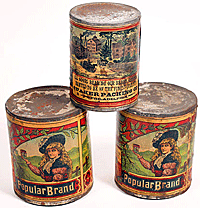 The
Industrial Revolution brought mass production and distribution to
Britain beginning in the 1750s. By the beginning of the 19th century,
this affected food packaging, making it more durable, easier to produce,
and more accessible. The
Industrial Revolution brought mass production and distribution to
Britain beginning in the 1750s. By the beginning of the 19th century,
this affected food packaging, making it more durable, easier to produce,
and more accessible.
Beginning in the 1800s, food producers started using tins to hold
spices, teas, and coffee because of the air-tight seals. Larger painted
ones held these items in bulk in shops to keep them fresh before sale.
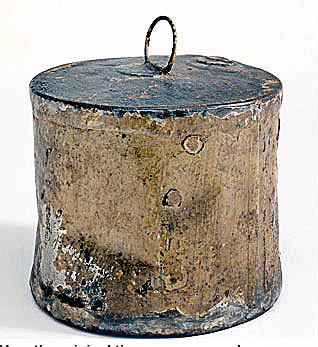 In 1805, French General Napoleon Bonaparte offered 12,000 francs to
anyone who could preserve food for his army. This led to the first
“canning” technique, founded by confectioner Nicholas Appert. He sealed
cooked food in glass containers and boiled them for sterilization.
In 1805, French General Napoleon Bonaparte offered 12,000 francs to
anyone who could preserve food for his army. This led to the first
“canning” technique, founded by confectioner Nicholas Appert. He sealed
cooked food in glass containers and boiled them for sterilization.
Later in 1810, British inventor Peter Durand patented his own canning
method using tin instead of glass. By 1820 he was supplying canned food
to the Royal Navy in large quantities.
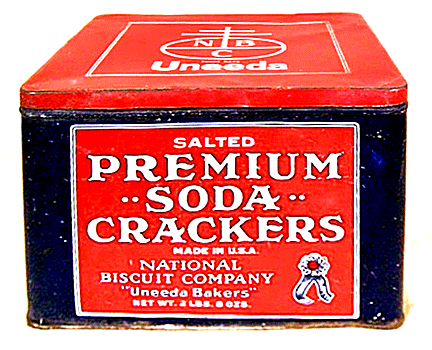 By
the 1870s, offset lithography and transfer printing meant advertising at
the point-of-purchase became bolder and brighter to attract the
shopper’s eye. And, because tin was so easily manipulated, sizes and
shapes were easily adapted to meet the needs of the shopkeeper and the
consumer, and could be used over and over again. By
the 1870s, offset lithography and transfer printing meant advertising at
the point-of-purchase became bolder and brighter to attract the
shopper’s eye. And, because tin was so easily manipulated, sizes and
shapes were easily adapted to meet the needs of the shopkeeper and the
consumer, and could be used over and over again.
Early Food Containers
At first food containers were rather basic but over time food packaging
developed into a necessary form of distribution. Not only did the
containers keep the food fresh, the labels on the outside helped to
advertise the product on store shelves.
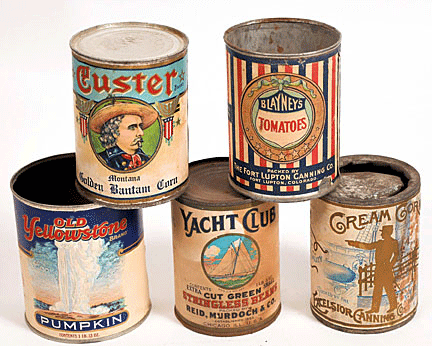
Once the problem of creating durable food packaging such as tin cans had
been solved, package design became important as it was the only way food
producers could get attention for their products. The manufacturers of
drugs, paint, oil and, of course, all food items worked to establish a
visual logo or trademark.
The use of little tins to hold various groceries, from cookies and
crackers to coffee and spices, goes back to the late 19th century.
John Huntingdon Hartford founded the Great Atlantic and Pacific Tea
Company, commonly known as A&Pin 1859. He peddled coffees and teas out
of gold and vermillion horse-drawn wagons and tiny, yet opulent,
Oriental-themed retail shops before gradually adding a few kitchen
staples like flour, sugar, baking powder and spices to its product mix.
He packaged the items he sold with the name of his company, A&P.
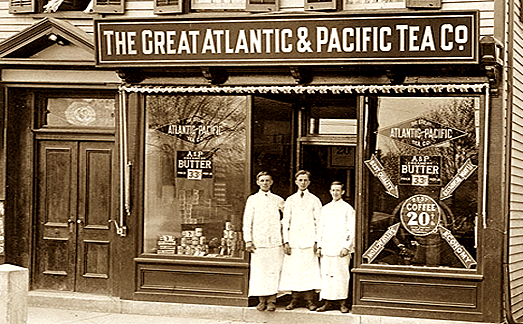
The first commercial cardboard box was produced in England in 1817. And
by 1856, corrugated paper first appeared in England as a liner for tall
hats. By the early 1900s, shipping cartons made of it replaced wooden
crates and boxes.
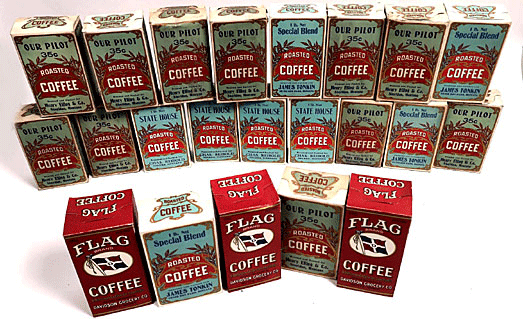
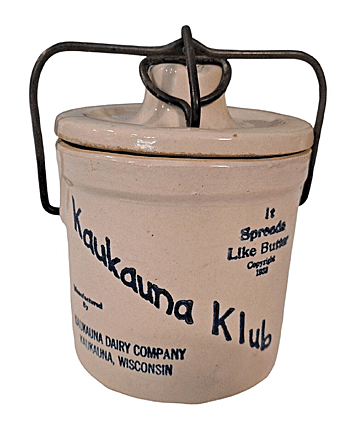 Eventually,
food manufacturers began using packaging containers that consumers were
reluctant to discard. For example, Lambrecht Butter, found primarily
east of the Mississippi, came packaged in an attractive gray or white
stoneware tub with blue script. Another favorite, Kaukauna Klub Cheddar
Cheese, came in a clay crock with a heavy wire clamp. Eventually,
food manufacturers began using packaging containers that consumers were
reluctant to discard. For example, Lambrecht Butter, found primarily
east of the Mississippi, came packaged in an attractive gray or white
stoneware tub with blue script. Another favorite, Kaukauna Klub Cheddar
Cheese, came in a clay crock with a heavy wire clamp.
The Move Towards Useful Packaging
A tin of Sultana Peanut Butter, which came in a large pail with wire
handles, made the perfect sand bucket to take to the beach in summer.
Other similar containers included the log-cabin-shaped tin holding Log
Cabin Syrup. People reused biscuit tins to hold everything from petty
cash to old buttons and homemade cookies.
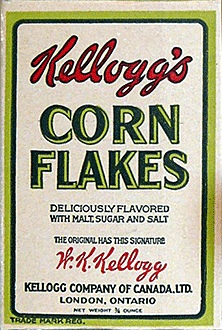 The
widespread practice of packing food in tin cans and containers was a
direct result of the public's acceptance of the Germ Theory of Disease.
In the 19th century, many Americans were still oblivious to the research
done by Louis Pasteur and Robert Koch in food preservation. The
widespread practice of packing food in tin cans and containers was a
direct result of the public's acceptance of the Germ Theory of Disease.
In the 19th century, many Americans were still oblivious to the research
done by Louis Pasteur and Robert Koch in food preservation.
Today, some people look down on those who eat canned or processed food
as something people without access to fresh food eat. But in the late
19th century, food in tins was highly desirable. Consumers considered it
more sanitary, and therefore healthier, than food offered in bins or
barrels at the General Store. That’s when branding became particularly
important; customers learned they could expect a certain level of
quality from, say, Kellogg’s.
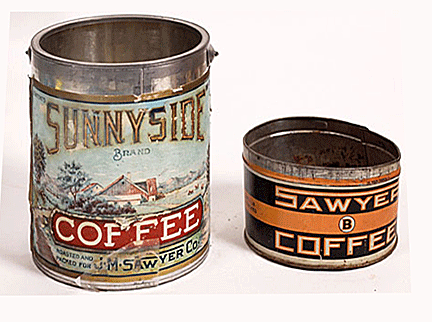 At
first, manufacturers covered tinplate containers with paper labels,
which had a product’s pertinent information and advertising stenciled or
printed on them. Machines that could trim and stamp sheets of tin had
been introduced around 1875, and between 1869 and 1895, manufacturers
developed a process that allowed them to use lithography to transfer
images directly onto the tin containers. Coffee and tea, as well as
tobacco and beverages and snack foods came packaged in tins. At
first, manufacturers covered tinplate containers with paper labels,
which had a product’s pertinent information and advertising stenciled or
printed on them. Machines that could trim and stamp sheets of tin had
been introduced around 1875, and between 1869 and 1895, manufacturers
developed a process that allowed them to use lithography to transfer
images directly onto the tin containers. Coffee and tea, as well as
tobacco and beverages and snack foods came packaged in tins.
Collecting Antique Food Containers
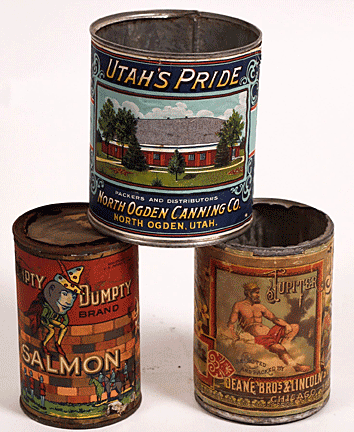 Of
all the antique and vintage items available to collect, nothing beats
grocery and food containers. Considering the thousands of items sold in
the average supermarket, it’s no wonder that collectors seek out those
that once graced the shelves of general and dry goods stores from the
mid 19th to the mid 20th centuries. Of
all the antique and vintage items available to collect, nothing beats
grocery and food containers. Considering the thousands of items sold in
the average supermarket, it’s no wonder that collectors seek out those
that once graced the shelves of general and dry goods stores from the
mid 19th to the mid 20th centuries.
While food containers have been around for over 200 years, it wasn’t
until the invention of the tin can and the cardboard box that they
really got interesting and highly collectible.
There are three advantages to collecting old food and grocery
containers—one is that they’re generally affordable, two is that they
don’t take up too much space, and three is that they lend themselves to
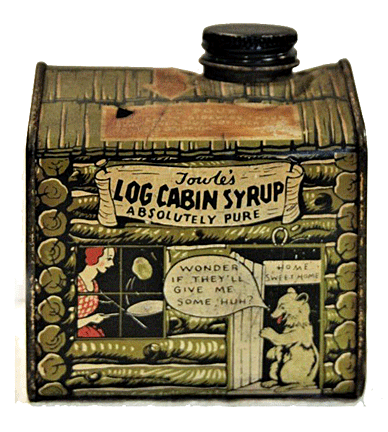 decorating.
For collectors who live in condos or apartments, the latter is a
definite plus. As far as decorating is concerned, the colorful labels on
cans and boxes add a splash of color while their bold graphics add
interest. decorating.
For collectors who live in condos or apartments, the latter is a
definite plus. As far as decorating is concerned, the colorful labels on
cans and boxes add a splash of color while their bold graphics add
interest.
Lithographed candy pails can range in price from $50 to $350 depending
on theme and condition.
Overall, prices for tins vary greatly, but there is something for every
person’s budget. The older and rarer the tin, the more valuable it will
be, with advertising tins from unknown companies commanding higher
prices. Beware of reproductions if you are looking for a true antique.
Expect to see paint loss, dents, rust, and overall signs of use. This
does not always detract from overall value, but shows as a history of
use and that is a good thing.
< Back to Collecting Archives
Next Article > |
